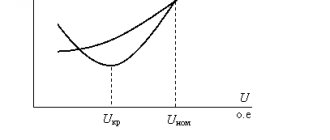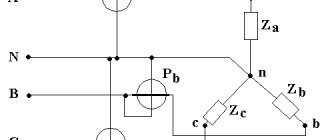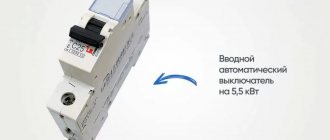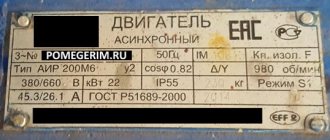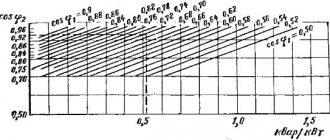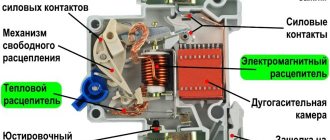Calculation of a resistor for an LED
Program for calculating resistor resistance for an LED
You can make the necessary calculations online using a specialized calculator. Full use of such programs is offered free of charge.
However, access to the Internet is not always available. After studying a fairly simple technique, anyone can quickly select a resistor for an LED without searching for the appropriate software.
To clearly demonstrate the algorithm, you need to consider connecting a protective resistor to the power circuit (5 V) of a certain LED (Epistar 1W HP).
Technical specifications:
- dissipation power, W – 1;
- current, mA – 350;
- forward voltage (typical/max.), V – 2.35/2.6.
To limit the LED current, taking into account the manufacturer's recommendations, a resistor with electrical resistance R = (5-2.35)/0.35 = 7.57 Ohms is suitable. According to the E24 standard, the closest values are 7.5 and 8.2 Ohms. If you use standard rules, you will have to choose a larger value that differs from the calculated one by almost 8.5%. An additional error will be created by a 5% tolerance for mass-produced inexpensive products. With such a deviation, it is difficult to obtain acceptable circuit characteristics in terms of protective functions and power consumption.
The first way to solve the problem is to select several resistors with lower values. Next, a series, parallel or combined connection option is used to obtain the required equivalent resistance of the circuit section. The second method is to add a trim resistor.
Classification of transistors and their main parameters
Definition 1
A transistor is a semiconductor device with at least two p-h junctions and three terminals, which is designed to amplify, convert and generate electrical oscillations.
The main classification of transistors is carried out according to:
- The original semiconductor material. According to this criterion, transistors are divided into silicon and germanium.
- Power. According to this criterion, transistors are divided into high, medium and low power transistors.
- Frequency. According to this criterion, transistors are divided into ultra-high-frequency, high-frequency, mid-frequency, low-frequency.
In radio engineering, the most common transistors are field-effect and bipolar. In field-effect transistors, the output electric current is controlled by an electric field. Field transformers have three electrodes: drain, source and gate. The advantage of a field-effect transistor is that the electric current of the gate (input electrode) is very small, which determines the high input resistance of the cascades on them, which helps eliminate the influence of subsequent cascades of the circuit on the previous ones. The main parameters of field-effect transistors include:
Are you an expert in this subject area? We invite you to become the author of the Directory Working Conditions
- Cut-off voltage.
- Voltages between drain and gate, between gate and source, between drain and source.
- Maximum electric drain current.
In the semiconductor structure of a bipolar transistor, two p-n junctions are formed, charge transfer through which is carried out by two carriers - holes and electrons. This transistor is used in devices that generate or amplify electrical oscillations, and sometimes as a switching element. The main parameters of this type of transistor are: input resistance, maximum permissible electric current, input conductivity, current transfer coefficient, reverse collector current, turn-on time, output conductivity and others.
Calculation of power dissipation
In any of the options, when choosing the electrical resistance of the circuit, you should set a slightly lower current in order to extend the life of the LED. To prevent heat damage, use the product within the recommended temperature range. For Epistar 1W HP – from -40°C to +80°C. If necessary, use installation on a specialized “star” radiator. This addition increases the effective heat dissipation area.
For accurate selection, estimate the power dissipation of the resistor: P = I2 * R = (0.35)2 * 7.57 = 0.1225 * 7.57 ≈0.93 W. The reserve for this parameter is made at least 20-25%. The 1 W rating is not enough, so choose the next rating in the standard series - 2 W.
The efficiency of the assembled circuit is checked by the ratio Uc/Ui = 2.35/5 = 0.47 (47%). The final result shows that more than half of the electricity in this case is wasted. In fact, the indicator is even worse, since not all the power consumption is spent by the LED on radiation in the visible part of the spectrum. A significant part is electromagnetic waves in the infrared range.
How to calculate the power of a resistor in a circuit
To calculate the power of resistors in a circuit, in addition to resistance (R), you need to know the current strength (I). Based on these data, the power can be calculated. The formula is usual: P = I² * R. The square of the current strength is multiplied by the resistance. We substitute the current strength in Amperes, the resistance in Ohms.
If the denomination is written in kilo-ohms (kOhm) or mega-ohm (mOhm), we convert it to Ohms. This is important, otherwise the number will be wrong.
Diagram of series connection of resistors
For example, consider the diagram in the figure above. A series connection of resistances is characterized by the fact that the same current flows through each individual resistor in the circuit. This means the resistance power will be the same. Series connected resistances are simply summed up: 200 Ohms + 100 Ohms + 51 Ohms + 39 Ohms = 390 Ohms. We calculate the current using the formula: I = U/R. We substitute the data: I = 100 V / 390 Ohm = 0.256 A.
Based on the calculated data, we determine the total power of the resistances: P = 0.256² * 390 Ohm = 25.549 W. The power of each resistor is calculated in the same way. For example, let's calculate the power of resistor R2 in the diagram. We know the current, its nominal value too. We get: 0.256A² * 100 Ohm = 6.55 W. That is, the power of this resistor must be at least 7 W. It’s definitely not worth taking with a lower power - it will quickly burn out. If the design of the device allows, then you can install a resistor of higher power, for example, 10 W.
There are MLT series resistors in which the heat dissipation power is indicated immediately after the series name without any letters. In this case, MLT-2 means that the power of this instance is 2 W, and the nominal value is 6.8 kOhm.
For a parallel connection, the calculation is similar. You just need to correctly calculate the current, but that’s a topic for another article. And the formula for calculating the power of a resistor does not depend on the type of connection.


